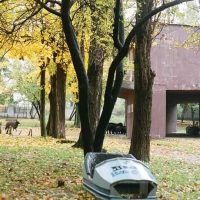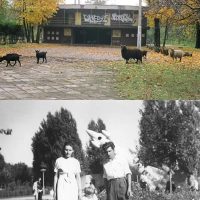Hollauf’s photos of Dunaújváros depict once-popular settings that have since been forgotten, such as the surreal present-day image of the Amusement Park with sheep and bumper cars stranded on the grass, as well as the blue stage located on Szalki Island. The latter reminds viewers of the festivities of a past era. In spite of its rundown and neglected condition, however, it seems as if the great blue stage still held the promise of an impressive spectacle to non-existent performers.
Similarly to the Dunaújváros Amusement Park series, the photos taken in Leipzig, Vienna and Krakow all document spaces of recreation, which were established in the 1960s and 1970s, and which by now have mostly become abandoned. The subject of Hollauf’s focus is not exclusively the post-socialist state, but comprehensive urban planning and social models, in general. That is to say, post-war urban planning aspired to shape people’s recreational time and social activities both in the West and in the East.
While there is a significant difference between the intentions of social influence and social control, both socialist and social democratic states conceived of establishing public spaces designated for recreational activities as a means of acknowledging collectively achieved results. In addition to securing access to recreational and cultural programs, shaping the public sphere and ensuring opportunities for participating in the life of the community were considered important priorities in both cases.
Isabella Hollauf’s exhibition, through its examination of the utopias of past societies, raises numerous questions that are still relevant today: How have social expectations changed and what do we mean by leisure time today? How has leisure time become the target of neoliberal service industries and what are the new forms of architecture that have come into existence? In other words: How does corporate leisure economics influence the demands of ever younger generations and how have playgrounds, public outdoor pools and open beaches been replaced by adventure parks and water parks?

